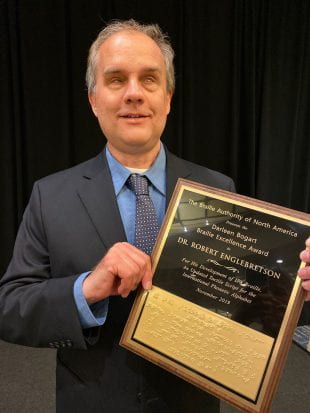The international phonetic alphabet (IPA) is a set of symbols used to represent all of the possible speech sounds in the nearly 7,000 languages currently spoken on Earth, but until recently, the braille version of the IPA was incomplete and nearly 75 years out of date.
Robert Englebretson, professor and chair of linguistics at Rice University, was honored Nov. 13 with the Darleen Bogart Braille Excellence Award from the Braille Authority of North America (BANA) for his work to develop an updated tactile script for this system, which is critical to pronouncing and understanding the world’s languages.
The award, presented at the biennial Getting in Touch with Literacy Conference in Seattle, was created in 2009 in honor of Louis Braille’s 200th birthday and renamed in 2019 in recognition of the retirement of Bogart, who was one of BANA’s founding members. Englebretson is the sixth recipient.
“It’s a great honor to receive this award,” Englebretson said. “Linguists use IPA extensively for documenting endangered languages as well as varieties of widely spoken languages too, like the vast diversity of ways people pronounce English around the U.S. and the world. It’s also used in fields like speech and language pathology, vocal music or dialect coaching, and any time there is a need for a precise representation of speech sounds. Even Wikipedia uses it to illustrate pronunciation.
“A complete and updated braille version of the IPA empowers those of us who work in the language sciences full access to these areas through braille, and also represents the amazing flexibility and adaptability of braille to be used widely in academic pursuits.”
Englebretson developed and teaches a course that examines research on braille reading and writing from the perspective of the cognitive sciences. He is the author of two books and numerous academic articles and has co-edited a large research database of conversational English. He is currently collaborating on a first-of-its-kind study that seeks to improve braille literacy by exploring questions about how it’s taught; some teachers see braille as a code representing print, while others consider it a writing system serving as a direct path to literacy, and the research will examine how those viewpoints impact students.
For more information on Englebretson, visit https://www.ruf.rice.edu/~reng/. For more information on BANA, visit http://www.brailleauthority.org/.


